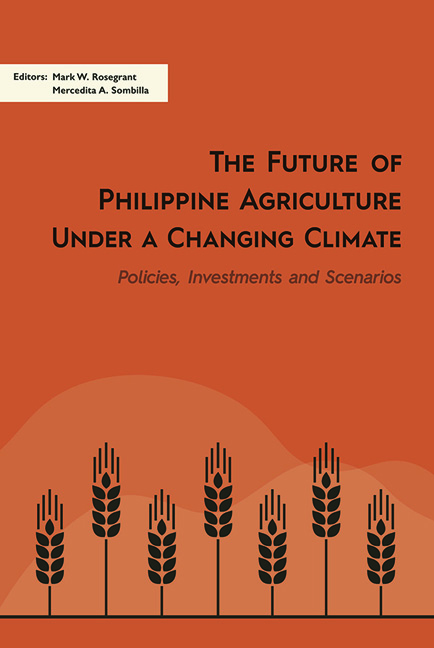Book contents
- Frontmatter
- Contents
- List of Tables
- List of Figures
- List of Appendices
- Preface
- Acknowledgements
- List of Contributors
- PART I Setting up the Scenarios: Current Status and Potential Impacts of Climate Change to Philippine Agriculture
- PART II Climate Change Adaptation Strategies and Sustainability of Philippine Agriculture
- PART III Investments and Supporting Policies to Alleviate Climate Change Impacts to Philippine Agriculture
- 9 A Biophysical Approach to Modelling Alternative Agricultural Futures under Climate Change
- 10 A Partial Equilibrium Approach to Modelling Alternative Agricultural Futures under Climate Change
- 11 A General Equilibrium Approach to Modelling Alternative Agricultural Futures under Climate Change
- PART IV Conclusion
- Index
9 - A Biophysical Approach to Modelling Alternative Agricultural Futures under Climate Change
from PART III - Investments and Supporting Policies to Alleviate Climate Change Impacts to Philippine Agriculture
Published online by Cambridge University Press: 29 May 2019
- Frontmatter
- Contents
- List of Tables
- List of Figures
- List of Appendices
- Preface
- Acknowledgements
- List of Contributors
- PART I Setting up the Scenarios: Current Status and Potential Impacts of Climate Change to Philippine Agriculture
- PART II Climate Change Adaptation Strategies and Sustainability of Philippine Agriculture
- PART III Investments and Supporting Policies to Alleviate Climate Change Impacts to Philippine Agriculture
- 9 A Biophysical Approach to Modelling Alternative Agricultural Futures under Climate Change
- 10 A Partial Equilibrium Approach to Modelling Alternative Agricultural Futures under Climate Change
- 11 A General Equilibrium Approach to Modelling Alternative Agricultural Futures under Climate Change
- PART IV Conclusion
- Index
Summary
The Philippines is noted for its climatic and ecological diversity, being a nation of many islands and spanning a large number of latitudes; hence, the impact of climate change would not be expected to be uniform. Yet, even if the changes were to have negative impacts on crop yields in every location, the question remains as to how bad such impacts may be. Will the impact be unequivocally negative, or might some parts of the country experience positive agricultural impacts? And could identifying places likely to experience negative outcomes ahead of time help people to plan and adapt? A 5 per cent yield loss, for example, is not so serious when compared with, say, a 40 per cent loss, and preparations would certainly differ depending on the extremes anticipated. There is also the question of climate change having differential impacts on crop yields. What if climate change negatively affects one crop in a given location, but positively affects another in the same location? Could this information help farmers and policymakers to prepare for what the future may bring?
This chapter presents the results of research designed to fill gaps in the knowledge base about the intensity of the impacts of climate change on agriculture in the Philippines, taking a spatially disaggregated approach intended to differentiate the impacts across regions. The research employed crop-modelling software together with the latest climate models to evaluate the impact of climate change on key crops. With this knowledge in hand, policymakers, researchers, and farmers should be better equipped to both prepare for and adapt to the impacts of climate change. To date, most of what has been published about the impact of climate change on agriculture has been based on climate models from the Fourth Assessment Report (AR4) of the Intergovernmental Panel on Climate Change (IPCC), or even earlier. The research in this chapter is based on climate models from the IPCC's Fifth Assessment Report (AR5), which was published beginning in 2013 and provides the most accurate, up-to-date predictions available.
The analysis presented in this chapter is based on the regional divisions presented in Figure 9.1 The main land cover in each (approximately) 500-metre grid-cell is presented in Figure 9.2.
- Type
- Chapter
- Information
- The Future of Philippine Agriculture under a Changing ClimatePolicies, Investments and Scenarios, pp. 377 - 449Publisher: ISEAS–Yusof Ishak InstitutePrint publication year: 2018

